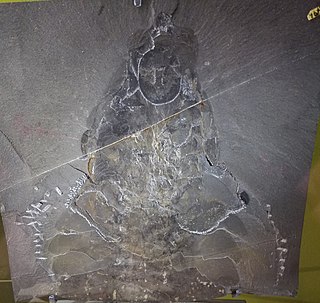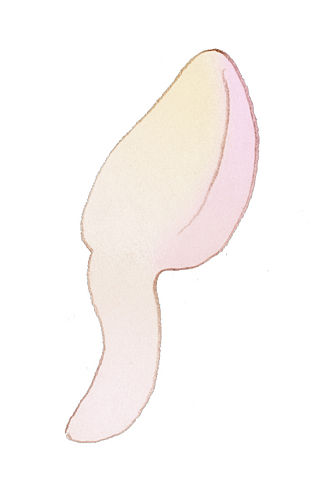Related Research Articles

Hallucigenia is a genus of Cambrian animal resembling worms, known from articulated fossils in Burgess Shale-type deposits in Canada and China, and from isolated spines around the world. The generic name reflects the type species' unusual appearance and eccentric history of study; when it was erected as a genus, H. sparsa was reconstructed as an enigmatic animal upside down and back to front. Hallucigenia was later recognized as a lobopodian, a grade of Paleozoic panarthropods from which the velvet worms, water bears, and arthropods arose.

Opabinia regalis is an extinct, stem group arthropod found in the Middle Cambrian Burgess Shale Lagerstätte of British Columbia. Opabinia was a soft-bodied animal, measuring up to 7 cm in body length, and its segmented trunk had flaps along the sides and a fan-shaped tail. The head shows unusual features: five eyes, a mouth under the head and facing backwards, and a clawed proboscis that probably passed food to the mouth. Opabinia probably lived on the seafloor, using the proboscis to seek out small, soft food. Fewer than twenty good specimens have been described; 3 specimens of Opabinia are known from the Greater Phyllopod bed, where they constitute less than 0.1% of the community.

Marrella is an extinct genus of marrellomorph arthropod known from the middle Cambrian Burgess Shale of British Columbia. It is the most common animal represented in the Burgess Shale, with tens of thousands of specimens collected. Much rarer remains are also known from deposits in China.

Anomalocaris is an extinct genus of radiodont, an order of early-diverging stem-group arthropods. The first fossils of Anomalocaris were discovered in the Ogygopsis Shale of the Stephen Formation in British Columbia, Canada by Joseph Frederick Whiteaves, with more examples found by Charles Doolittle Walcott in the Burgess Shale unit of the Stephen Formation. Other closely related fossils have been found in the older Emu Bay Shale of Australia, as well as possibly elsewhere. Originally several fossilized parts discovered separately were thought to be three separate creatures, a misapprehension corrected by Harry B. Whittington and Derek Briggs in a 1985 journal article. With a body length close to 40 centimetres, A. canadensis is thought to be one of the earliest examples of an apex predator, though others have been found in older Cambrian lagerstätten deposits.

Peytoia is a genus of hurdiid radiodont, an early diverging order of stem-group arthropods, that lived in the Cambrian period, containing two species, Peytoia nathorsti from the Miaolingian of Canada and Peytoia infercambriensis from Poland, dating to Cambrian Stage 3. Its two frontal appendages had long bristle-like spines, it had no fan tail, and its short stalked eyes were behind its large head.

Waptia fieldensis is an extinct species of arthropod from the Middle Cambrian Burgess Shale Lagerstätte of Canada. It grew to a length of 6.65 cm (3 in), and had a large bivalved carapace and a segmented body terminating into a pair of tail flaps. It was an active swimmer and likely a predator of soft-bodied prey. It is also one of the oldest animals with direct evidence of brood care. Waptia fieldensis is the only species classified under the genus Waptia. Other specimens of Waptia are known from the Spence Shale in Utah.

Leanchoilia is an megacheiran arthropod known from Cambrian deposits of the Burgess Shale in Canada and the Chengjiang biota of China. It was about 5 centimetres (2.0 in) long and had long, whip-like flagellae extending from its great appendages. Its internal organs are occasionally preserved within the substrate in three dimensions.

Naraoia is a genus of small to average size marine arthropods within the family Naraoiidae, that lived from the early Cambrian to the late Silurian period. The species are characterized by a large alimentary system and sideways oriented antennas.

Parapeytoia is a prehistoric arthropod that lived over 530 million years ago in the Maotianshan shales of prehistoric China. It was interpreted as an anomalocaridid (radiodont) with legs, but later studies reveal it was a megacheiran, a group of arthropods which are no longer thought to be closely related to the radiodonts.

The Chancelloriids are an extinct family of superficially sponge-like animals common in sediments from the Early Cambrian to the early Late Cambrian. Many of these fossils consists only of spines and other fragments, and it is not certain that they belong to the same type of organism. Other specimens appear to be more complete and to represent sessile, radially symmetrical hollow bag-like organisms with a soft skin armored with star-shaped calcareous sclerites from which radiate sharp spines.
Paleontology or palaeontology is the study of prehistoric life forms on Earth through the examination of plant and animal fossils. This includes the study of body fossils, tracks (ichnites), burrows, cast-off parts, fossilised feces (coprolites), palynomorphs and chemical residues. Because humans have encountered fossils for millennia, paleontology has a long history both before and after becoming formalized as a science. This article records significant discoveries and events related to paleontology that occurred or were published in the year 1912.

Capsospongia, formerly known as Corralia or Corralio, is a middle Cambrian sponge genus known from 3 specimens in the Burgess shale. Its type and only species is Capsospongia undulata. It has a narrow base, and consists of bulging rings which get wider further up the sponge, resulting in a conical shape. Its open top was presumably used to expel water that had passed through the sponge cells and been filtered for nutrients.

Actaeus is a Cambrian organism with a resemblance to the great appendage arthropods, containing the single species Actaeus armatus. It is known from a single specimen recovered from the Burgess Shale of British Columbia, Canada. The specimen is over 6 cm long and has a body consisting of a head shield, 11 body tergites, and a terminal plate.

Radiodonta is an extinct order of stem-group arthropods that was successful worldwide during the Cambrian period. They may be referred to as radiodonts, radiodontans, radiodontids, anomalocarids, or anomalocaridids, although the last two originally refer to the family Anomalocarididae, which previously included all species of this order but is now restricted to only a few species. Radiodonts are distinguished by their distinctive frontal appendages, which are morphologically diverse and used for a variety of functions. Radiodonts included the earliest large predators known, but they also included sediment sifters and filter feeders. Some of the most famous species of radiodonts are the Cambrian taxa Anomalocaris canadensis, Hurdia victoria, Peytoia nathorsti, Titanokorys gainessii, Cambroraster falcatus and Amplectobelua symbrachiata, the Ordovician Aegirocassis benmoulai and the Devonian Schinderhannes bartelsi.

Hurdia is an extinct genus of hurdiid radiodont that lived 505 million years ago during the Cambrian Period. As a radiodont like Peytoia and Anomalocaris, it is part of the ancestral lineage that led to euarthropods.
The fossils of the Burgess Shale, like the Burgess Shale itself, formed around 505 million years ago in the Mid Cambrian period. They were discovered in Canada in 1886, and Charles Doolittle Walcott collected over 65,000 specimens in a series of field trips up to the alpine site from 1909 to 1924. After a period of neglect from the 1930s to the early 1960s, new excavations and re-examinations of Walcott's collection continue to reveal new species, and statistical analysis suggests that additional discoveries will continue for the foreseeable future. Stephen Jay Gould's book Wonderful Life describes the history of discovery up to the early 1980s, although his analysis of the implications for evolution has been contested.

Priscansermarinus barnetti is an organism known from the Middle Cambrian Burgess Shale which was originally interpreted as a species of lepadomorph barnacle. Four specimens of P. barnetti are known from the Greater Phyllopod bed. A reflective area originally interpreted as external plates has been reinterpreted as a more complex structure inside the body; Derek Briggs, a leading authority on the arthropods of the Burgess Shale, has questioned its assignment as a barnacle or even an arthropod. The World Register of Marine Species places Priscansermarinus in Multicrustacea without assigning a class or order.

Collinsovermis is a genus of extinct panarthropod belonging to the group Lobopodia and known from the middle Cambrian Burgess Shale in British Columbia, Canada. It is monotypic having only one species, Collinsovermis monstruosus. After its initial discovery in 1983, Desmond H. Collins popularised it as a unique animal and was subsequently dubbed "Collins' monster" for its unusual super armoured body. The formal scientific description and name were given in 2020.
Percy Edward Raymond was a Harvard professor and paleontologist who specialized in the evolution of trilobites and studied fossils from the Burgess shales within which a region is named as the Raymond Quarry. He was among the careful explorers of the apparent explosion of life forms in the Cambrian period.
This is a list of the biota of the Burgess Shale, a Cambrian lagerstätte located in Yoho National Park in Canada.
References
- ↑ "Des Collins, Paleontologist: The Burgess Shale". 11 April 2012.